A Study of Leadership Skills for Group Conflict at Tesco UK
VerifiedAdded on 2023/04/21
|78
|14269
|393
Thesis and Dissertation
AI Summary
This dissertation investigates the critical role of leadership skills in managing group conflicts within Tesco UK, a multinational corporation with a diverse workforce. The study delves into the causes of conflict, including multiculturalism, leadership strategies, and communication barriers. It examines the impact of unresolved conflicts on production, employee satisfaction, and overall return on investment. The research employs a mixed-methods approach, including surveys and interviews, to gather data from Tesco employees. The findings reveal the significance of effective leadership in mitigating conflicts and fostering unity. The dissertation provides recommendations for implementing leadership skills and behavior management approaches to improve employee relations and enhance organizational performance. The study emphasizes the importance of addressing issues like language barriers, workplace diversity, and equitable reward systems. The research also highlights the limitations of the study, such as the need for a larger and more diverse sample size. The dissertation concludes with a call for Tesco to prioritize leadership development and implement strategies to promote a harmonious and productive work environment.
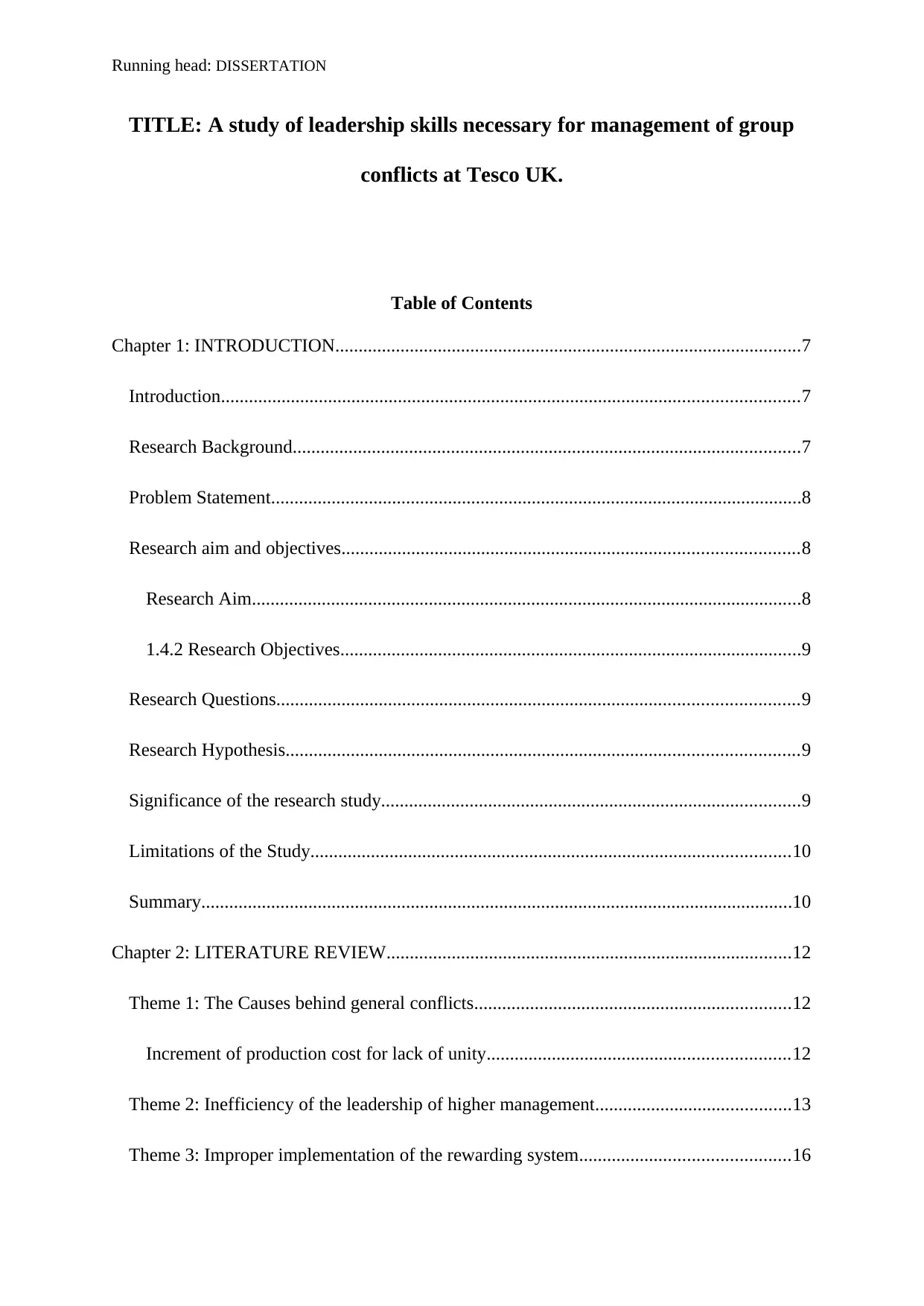
Running head: DISSERTATION
TITLE: A study of leadership skills necessary for management of group
conflicts at Tesco UK.
Table of Contents
Chapter 1: INTRODUCTION....................................................................................................7
Introduction............................................................................................................................7
Research Background.............................................................................................................7
Problem Statement..................................................................................................................8
Research aim and objectives..................................................................................................8
Research Aim......................................................................................................................8
1.4.2 Research Objectives...................................................................................................9
Research Questions................................................................................................................9
Research Hypothesis..............................................................................................................9
Significance of the research study..........................................................................................9
Limitations of the Study.......................................................................................................10
Summary...............................................................................................................................10
Chapter 2: LITERATURE REVIEW.......................................................................................12
Theme 1: The Causes behind general conflicts....................................................................12
Increment of production cost for lack of unity.................................................................12
Theme 2: Inefficiency of the leadership of higher management..........................................13
Theme 3: Improper implementation of the rewarding system.............................................16
TITLE: A study of leadership skills necessary for management of group
conflicts at Tesco UK.
Table of Contents
Chapter 1: INTRODUCTION....................................................................................................7
Introduction............................................................................................................................7
Research Background.............................................................................................................7
Problem Statement..................................................................................................................8
Research aim and objectives..................................................................................................8
Research Aim......................................................................................................................8
1.4.2 Research Objectives...................................................................................................9
Research Questions................................................................................................................9
Research Hypothesis..............................................................................................................9
Significance of the research study..........................................................................................9
Limitations of the Study.......................................................................................................10
Summary...............................................................................................................................10
Chapter 2: LITERATURE REVIEW.......................................................................................12
Theme 1: The Causes behind general conflicts....................................................................12
Increment of production cost for lack of unity.................................................................12
Theme 2: Inefficiency of the leadership of higher management..........................................13
Theme 3: Improper implementation of the rewarding system.............................................16
Paraphrase This Document
Need a fresh take? Get an instant paraphrase of this document with our AI Paraphraser
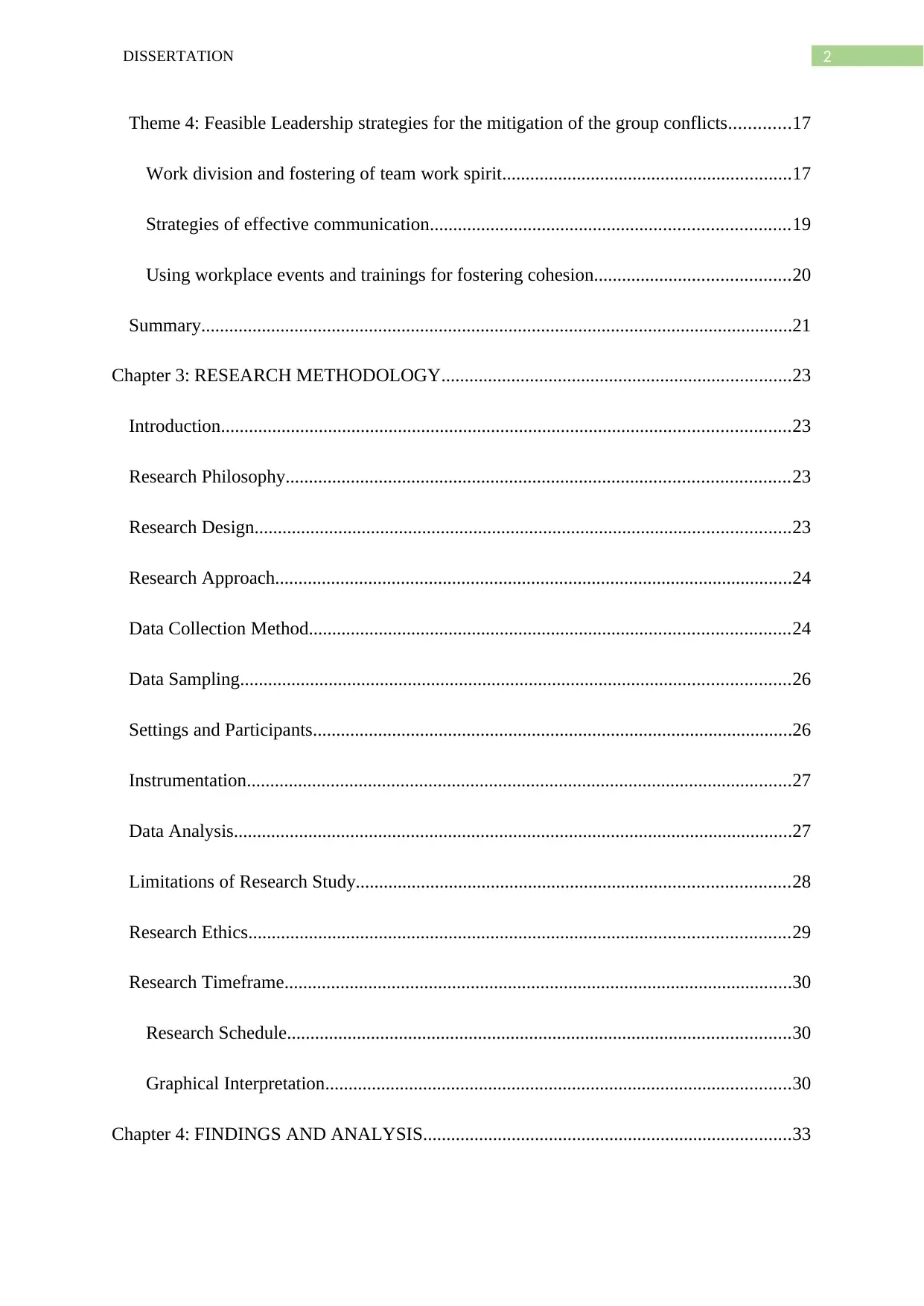
2DISSERTATION
Theme 4: Feasible Leadership strategies for the mitigation of the group conflicts.............17
Work division and fostering of team work spirit..............................................................17
Strategies of effective communication.............................................................................19
Using workplace events and trainings for fostering cohesion..........................................20
Summary...............................................................................................................................21
Chapter 3: RESEARCH METHODOLOGY...........................................................................23
Introduction..........................................................................................................................23
Research Philosophy............................................................................................................23
Research Design...................................................................................................................23
Research Approach...............................................................................................................24
Data Collection Method.......................................................................................................24
Data Sampling......................................................................................................................26
Settings and Participants.......................................................................................................26
Instrumentation.....................................................................................................................27
Data Analysis........................................................................................................................27
Limitations of Research Study.............................................................................................28
Research Ethics....................................................................................................................29
Research Timeframe.............................................................................................................30
Research Schedule............................................................................................................30
Graphical Interpretation....................................................................................................30
Chapter 4: FINDINGS AND ANALYSIS...............................................................................33
Theme 4: Feasible Leadership strategies for the mitigation of the group conflicts.............17
Work division and fostering of team work spirit..............................................................17
Strategies of effective communication.............................................................................19
Using workplace events and trainings for fostering cohesion..........................................20
Summary...............................................................................................................................21
Chapter 3: RESEARCH METHODOLOGY...........................................................................23
Introduction..........................................................................................................................23
Research Philosophy............................................................................................................23
Research Design...................................................................................................................23
Research Approach...............................................................................................................24
Data Collection Method.......................................................................................................24
Data Sampling......................................................................................................................26
Settings and Participants.......................................................................................................26
Instrumentation.....................................................................................................................27
Data Analysis........................................................................................................................27
Limitations of Research Study.............................................................................................28
Research Ethics....................................................................................................................29
Research Timeframe.............................................................................................................30
Research Schedule............................................................................................................30
Graphical Interpretation....................................................................................................30
Chapter 4: FINDINGS AND ANALYSIS...............................................................................33
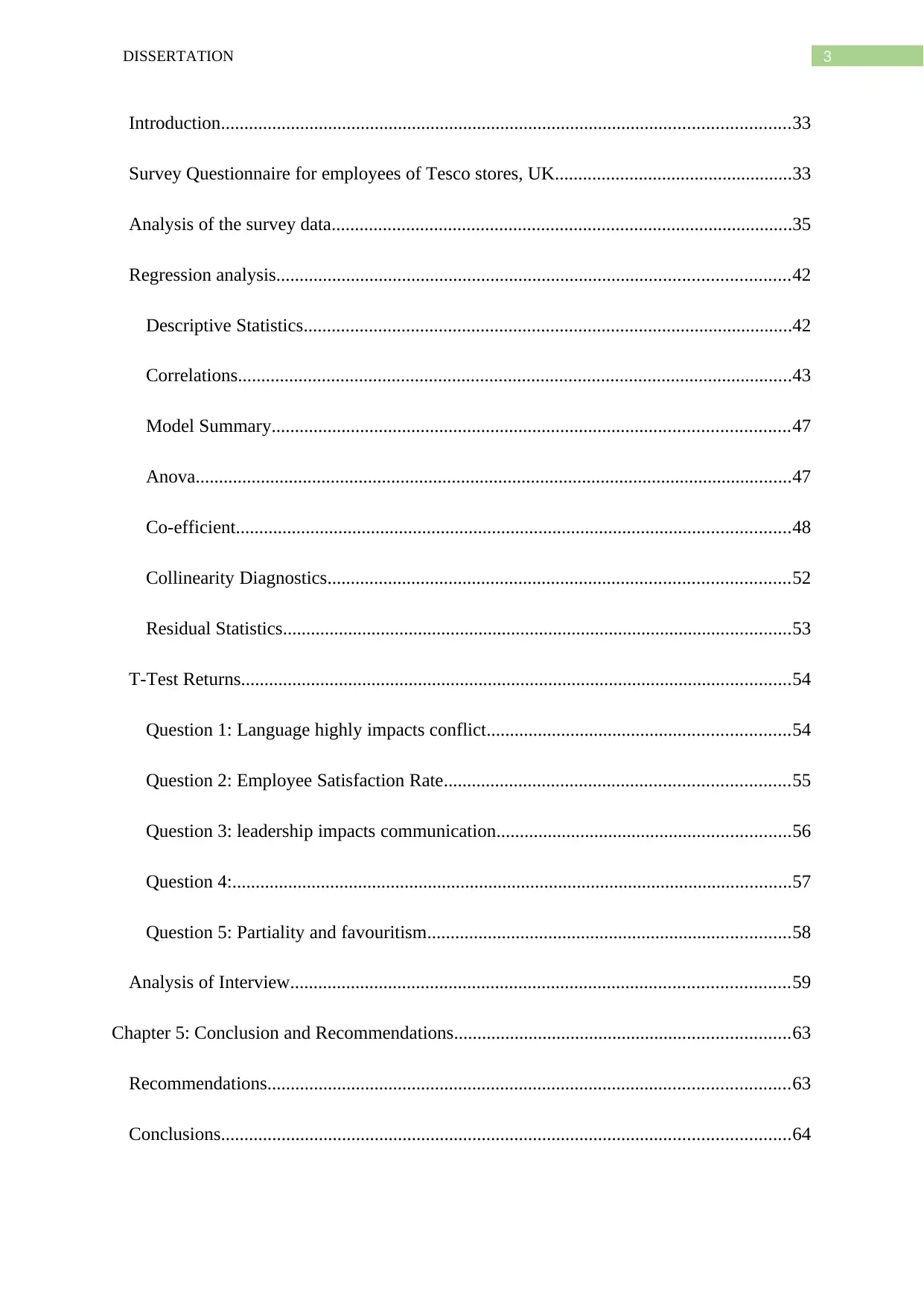
3DISSERTATION
Introduction..........................................................................................................................33
Survey Questionnaire for employees of Tesco stores, UK...................................................33
Analysis of the survey data...................................................................................................35
Regression analysis..............................................................................................................42
Descriptive Statistics.........................................................................................................42
Correlations.......................................................................................................................43
Model Summary...............................................................................................................47
Anova................................................................................................................................47
Co-efficient.......................................................................................................................48
Collinearity Diagnostics...................................................................................................52
Residual Statistics.............................................................................................................53
T-Test Returns......................................................................................................................54
Question 1: Language highly impacts conflict.................................................................54
Question 2: Employee Satisfaction Rate..........................................................................55
Question 3: leadership impacts communication...............................................................56
Question 4:........................................................................................................................57
Question 5: Partiality and favouritism..............................................................................58
Analysis of Interview...........................................................................................................59
Chapter 5: Conclusion and Recommendations........................................................................63
Recommendations................................................................................................................63
Conclusions..........................................................................................................................64
Introduction..........................................................................................................................33
Survey Questionnaire for employees of Tesco stores, UK...................................................33
Analysis of the survey data...................................................................................................35
Regression analysis..............................................................................................................42
Descriptive Statistics.........................................................................................................42
Correlations.......................................................................................................................43
Model Summary...............................................................................................................47
Anova................................................................................................................................47
Co-efficient.......................................................................................................................48
Collinearity Diagnostics...................................................................................................52
Residual Statistics.............................................................................................................53
T-Test Returns......................................................................................................................54
Question 1: Language highly impacts conflict.................................................................54
Question 2: Employee Satisfaction Rate..........................................................................55
Question 3: leadership impacts communication...............................................................56
Question 4:........................................................................................................................57
Question 5: Partiality and favouritism..............................................................................58
Analysis of Interview...........................................................................................................59
Chapter 5: Conclusion and Recommendations........................................................................63
Recommendations................................................................................................................63
Conclusions..........................................................................................................................64
⊘ This is a preview!⊘
Do you want full access?
Subscribe today to unlock all pages.

Trusted by 1+ million students worldwide

4DISSERTATION
Reference List..........................................................................................................................66
Appendix: Ethics Approval Form............................................................................................75
Reference List..........................................................................................................................66
Appendix: Ethics Approval Form............................................................................................75
Paraphrase This Document
Need a fresh take? Get an instant paraphrase of this document with our AI Paraphraser
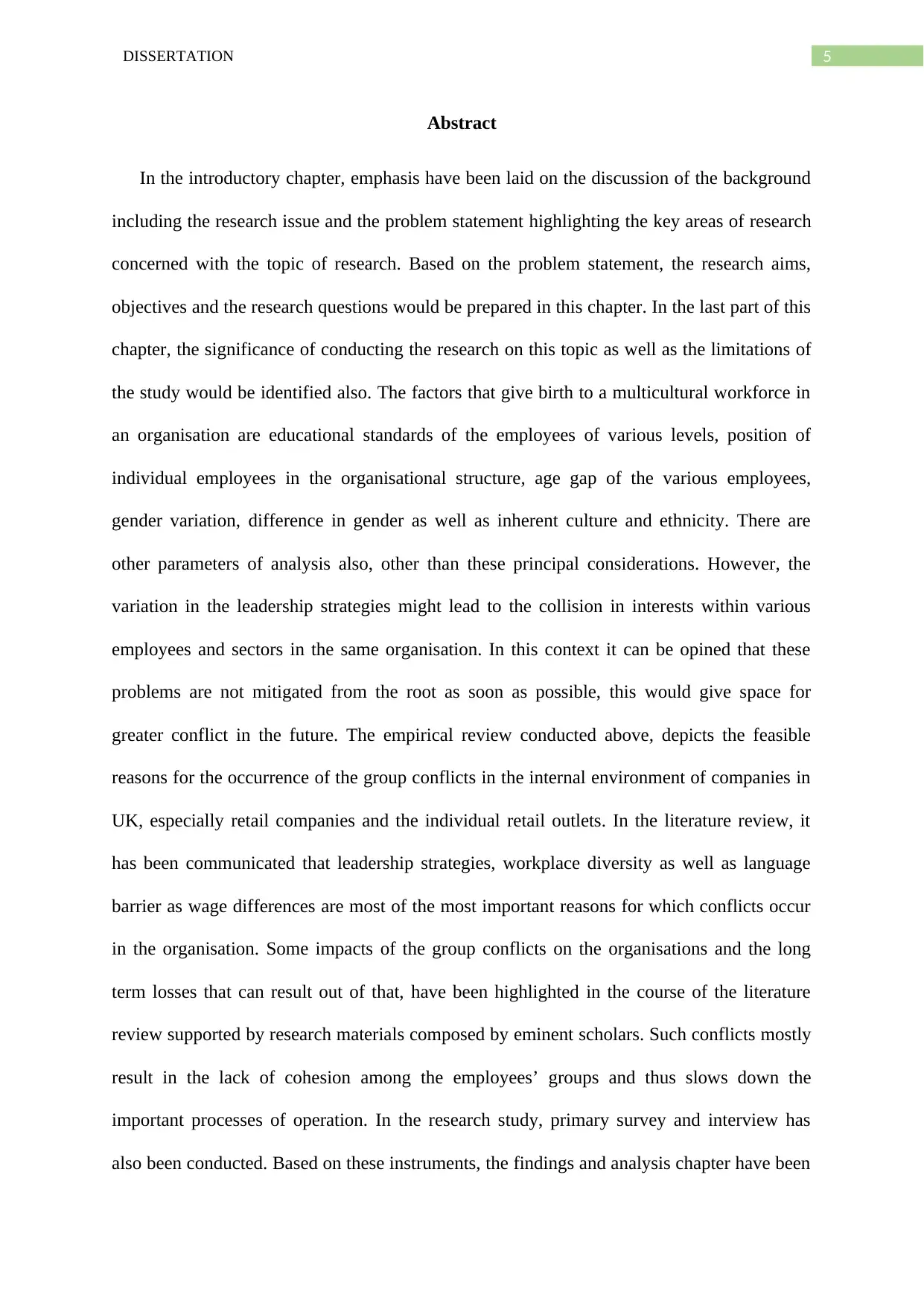
5DISSERTATION
Abstract
In the introductory chapter, emphasis have been laid on the discussion of the background
including the research issue and the problem statement highlighting the key areas of research
concerned with the topic of research. Based on the problem statement, the research aims,
objectives and the research questions would be prepared in this chapter. In the last part of this
chapter, the significance of conducting the research on this topic as well as the limitations of
the study would be identified also. The factors that give birth to a multicultural workforce in
an organisation are educational standards of the employees of various levels, position of
individual employees in the organisational structure, age gap of the various employees,
gender variation, difference in gender as well as inherent culture and ethnicity. There are
other parameters of analysis also, other than these principal considerations. However, the
variation in the leadership strategies might lead to the collision in interests within various
employees and sectors in the same organisation. In this context it can be opined that these
problems are not mitigated from the root as soon as possible, this would give space for
greater conflict in the future. The empirical review conducted above, depicts the feasible
reasons for the occurrence of the group conflicts in the internal environment of companies in
UK, especially retail companies and the individual retail outlets. In the literature review, it
has been communicated that leadership strategies, workplace diversity as well as language
barrier as wage differences are most of the most important reasons for which conflicts occur
in the organisation. Some impacts of the group conflicts on the organisations and the long
term losses that can result out of that, have been highlighted in the course of the literature
review supported by research materials composed by eminent scholars. Such conflicts mostly
result in the lack of cohesion among the employees’ groups and thus slows down the
important processes of operation. In the research study, primary survey and interview has
also been conducted. Based on these instruments, the findings and analysis chapter have been
Abstract
In the introductory chapter, emphasis have been laid on the discussion of the background
including the research issue and the problem statement highlighting the key areas of research
concerned with the topic of research. Based on the problem statement, the research aims,
objectives and the research questions would be prepared in this chapter. In the last part of this
chapter, the significance of conducting the research on this topic as well as the limitations of
the study would be identified also. The factors that give birth to a multicultural workforce in
an organisation are educational standards of the employees of various levels, position of
individual employees in the organisational structure, age gap of the various employees,
gender variation, difference in gender as well as inherent culture and ethnicity. There are
other parameters of analysis also, other than these principal considerations. However, the
variation in the leadership strategies might lead to the collision in interests within various
employees and sectors in the same organisation. In this context it can be opined that these
problems are not mitigated from the root as soon as possible, this would give space for
greater conflict in the future. The empirical review conducted above, depicts the feasible
reasons for the occurrence of the group conflicts in the internal environment of companies in
UK, especially retail companies and the individual retail outlets. In the literature review, it
has been communicated that leadership strategies, workplace diversity as well as language
barrier as wage differences are most of the most important reasons for which conflicts occur
in the organisation. Some impacts of the group conflicts on the organisations and the long
term losses that can result out of that, have been highlighted in the course of the literature
review supported by research materials composed by eminent scholars. Such conflicts mostly
result in the lack of cohesion among the employees’ groups and thus slows down the
important processes of operation. In the research study, primary survey and interview has
also been conducted. Based on these instruments, the findings and analysis chapter have been

6DISSERTATION
constructed. Using an interpretative and exploratory research methods, the data collection and
analysis have been conducted.
constructed. Using an interpretative and exploratory research methods, the data collection and
analysis have been conducted.
⊘ This is a preview!⊘
Do you want full access?
Subscribe today to unlock all pages.

Trusted by 1+ million students worldwide
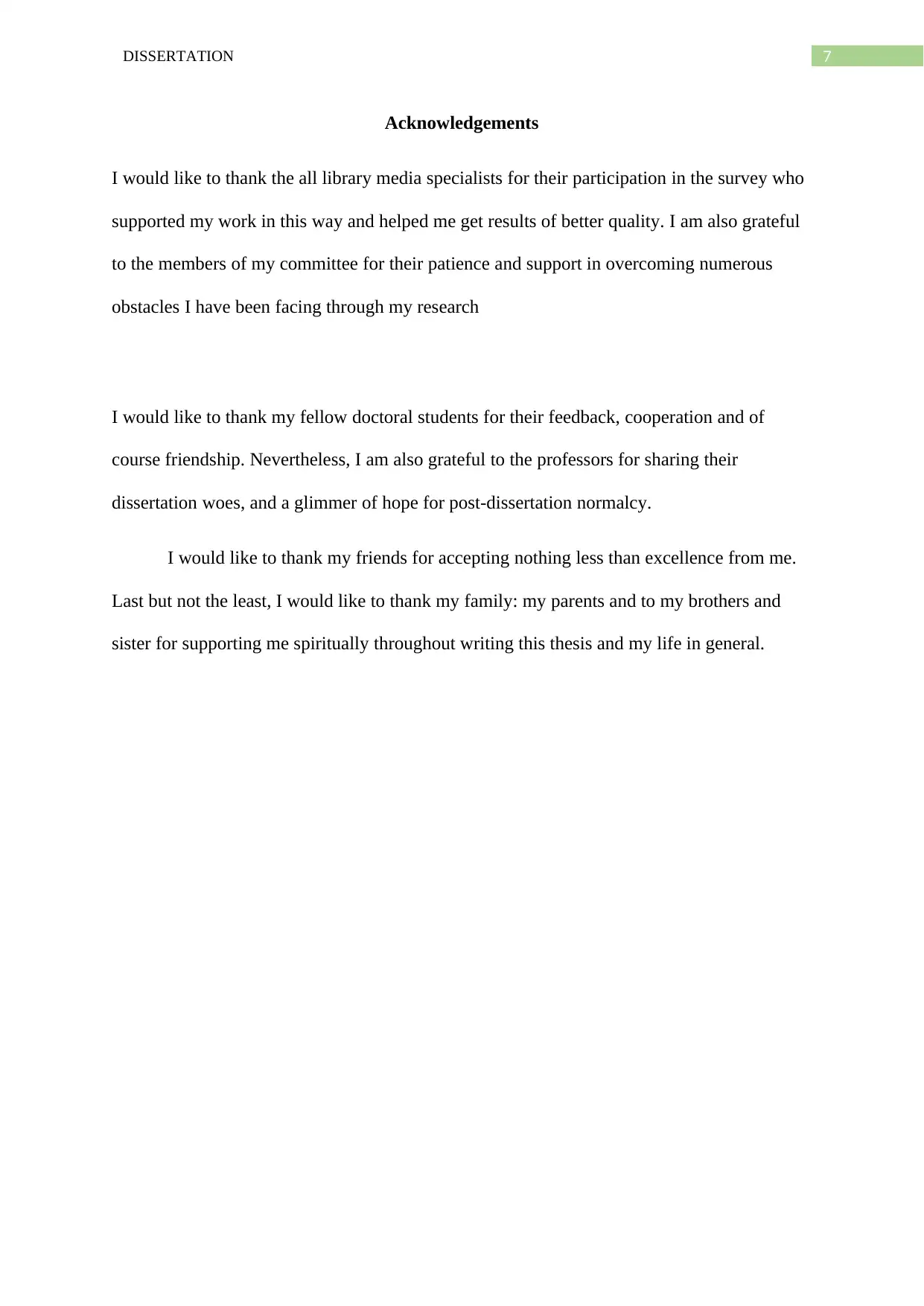
7DISSERTATION
Acknowledgements
I would like to thank the all library media specialists for their participation in the survey who
supported my work in this way and helped me get results of better quality. I am also grateful
to the members of my committee for their patience and support in overcoming numerous
obstacles I have been facing through my research
I would like to thank my fellow doctoral students for their feedback, cooperation and of
course friendship. Nevertheless, I am also grateful to the professors for sharing their
dissertation woes, and a glimmer of hope for post-dissertation normalcy.
I would like to thank my friends for accepting nothing less than excellence from me.
Last but not the least, I would like to thank my family: my parents and to my brothers and
sister for supporting me spiritually throughout writing this thesis and my life in general.
Acknowledgements
I would like to thank the all library media specialists for their participation in the survey who
supported my work in this way and helped me get results of better quality. I am also grateful
to the members of my committee for their patience and support in overcoming numerous
obstacles I have been facing through my research
I would like to thank my fellow doctoral students for their feedback, cooperation and of
course friendship. Nevertheless, I am also grateful to the professors for sharing their
dissertation woes, and a glimmer of hope for post-dissertation normalcy.
I would like to thank my friends for accepting nothing less than excellence from me.
Last but not the least, I would like to thank my family: my parents and to my brothers and
sister for supporting me spiritually throughout writing this thesis and my life in general.
Paraphrase This Document
Need a fresh take? Get an instant paraphrase of this document with our AI Paraphraser
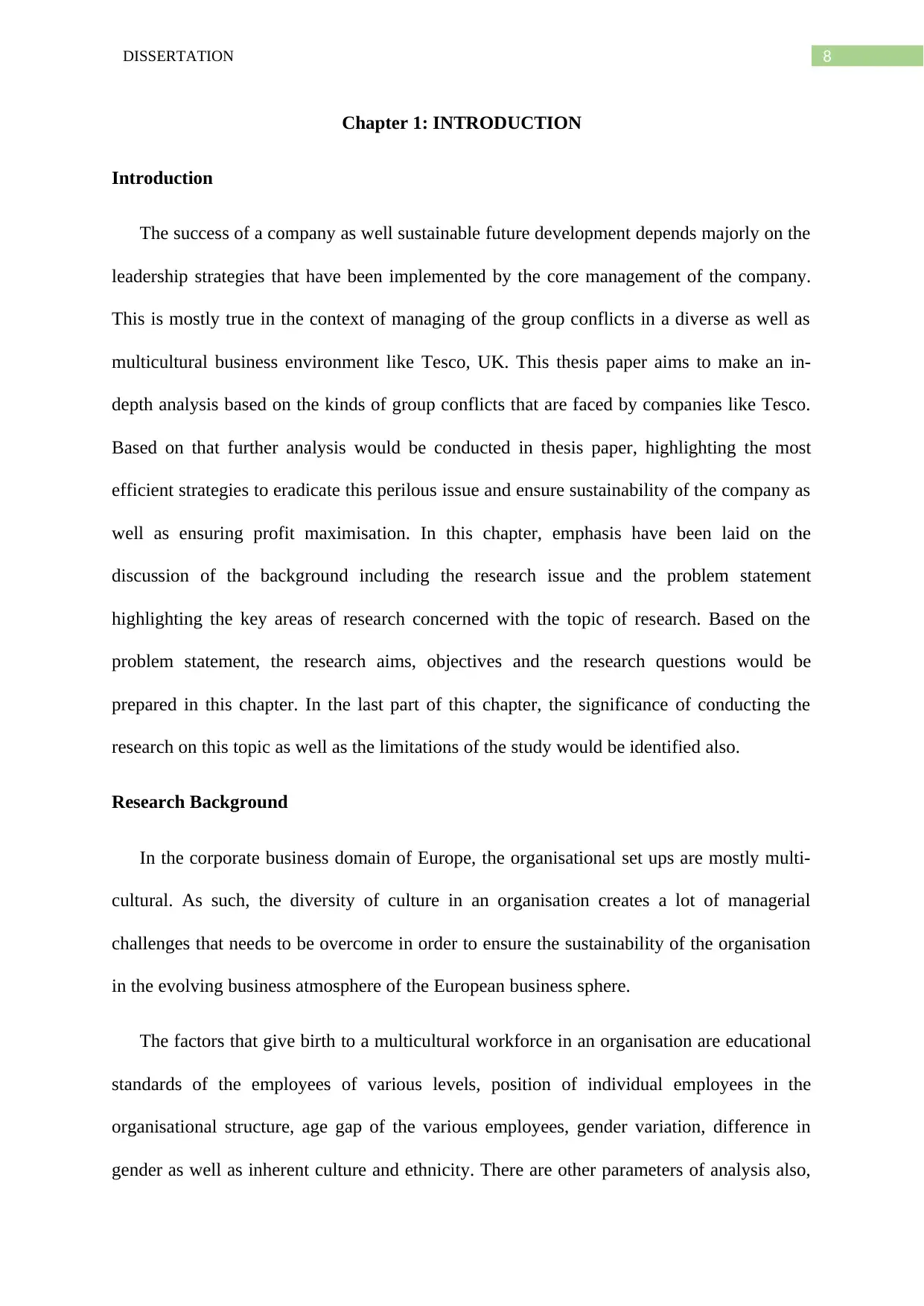
8DISSERTATION
Chapter 1: INTRODUCTION
Introduction
The success of a company as well sustainable future development depends majorly on the
leadership strategies that have been implemented by the core management of the company.
This is mostly true in the context of managing of the group conflicts in a diverse as well as
multicultural business environment like Tesco, UK. This thesis paper aims to make an in-
depth analysis based on the kinds of group conflicts that are faced by companies like Tesco.
Based on that further analysis would be conducted in thesis paper, highlighting the most
efficient strategies to eradicate this perilous issue and ensure sustainability of the company as
well as ensuring profit maximisation. In this chapter, emphasis have been laid on the
discussion of the background including the research issue and the problem statement
highlighting the key areas of research concerned with the topic of research. Based on the
problem statement, the research aims, objectives and the research questions would be
prepared in this chapter. In the last part of this chapter, the significance of conducting the
research on this topic as well as the limitations of the study would be identified also.
Research Background
In the corporate business domain of Europe, the organisational set ups are mostly multi-
cultural. As such, the diversity of culture in an organisation creates a lot of managerial
challenges that needs to be overcome in order to ensure the sustainability of the organisation
in the evolving business atmosphere of the European business sphere.
The factors that give birth to a multicultural workforce in an organisation are educational
standards of the employees of various levels, position of individual employees in the
organisational structure, age gap of the various employees, gender variation, difference in
gender as well as inherent culture and ethnicity. There are other parameters of analysis also,
Chapter 1: INTRODUCTION
Introduction
The success of a company as well sustainable future development depends majorly on the
leadership strategies that have been implemented by the core management of the company.
This is mostly true in the context of managing of the group conflicts in a diverse as well as
multicultural business environment like Tesco, UK. This thesis paper aims to make an in-
depth analysis based on the kinds of group conflicts that are faced by companies like Tesco.
Based on that further analysis would be conducted in thesis paper, highlighting the most
efficient strategies to eradicate this perilous issue and ensure sustainability of the company as
well as ensuring profit maximisation. In this chapter, emphasis have been laid on the
discussion of the background including the research issue and the problem statement
highlighting the key areas of research concerned with the topic of research. Based on the
problem statement, the research aims, objectives and the research questions would be
prepared in this chapter. In the last part of this chapter, the significance of conducting the
research on this topic as well as the limitations of the study would be identified also.
Research Background
In the corporate business domain of Europe, the organisational set ups are mostly multi-
cultural. As such, the diversity of culture in an organisation creates a lot of managerial
challenges that needs to be overcome in order to ensure the sustainability of the organisation
in the evolving business atmosphere of the European business sphere.
The factors that give birth to a multicultural workforce in an organisation are educational
standards of the employees of various levels, position of individual employees in the
organisational structure, age gap of the various employees, gender variation, difference in
gender as well as inherent culture and ethnicity. There are other parameters of analysis also,
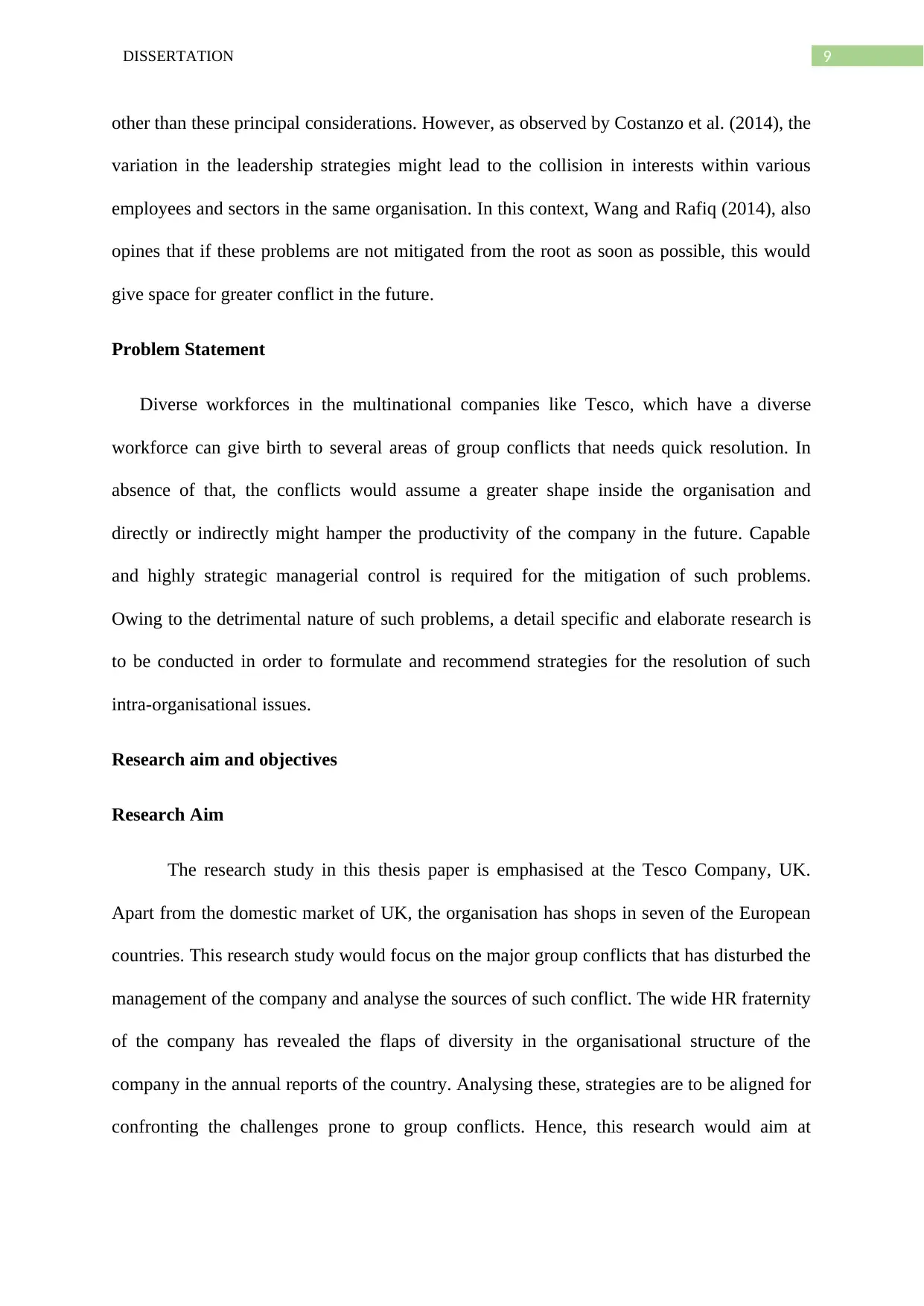
9DISSERTATION
other than these principal considerations. However, as observed by Costanzo et al. (2014), the
variation in the leadership strategies might lead to the collision in interests within various
employees and sectors in the same organisation. In this context, Wang and Rafiq (2014), also
opines that if these problems are not mitigated from the root as soon as possible, this would
give space for greater conflict in the future.
Problem Statement
Diverse workforces in the multinational companies like Tesco, which have a diverse
workforce can give birth to several areas of group conflicts that needs quick resolution. In
absence of that, the conflicts would assume a greater shape inside the organisation and
directly or indirectly might hamper the productivity of the company in the future. Capable
and highly strategic managerial control is required for the mitigation of such problems.
Owing to the detrimental nature of such problems, a detail specific and elaborate research is
to be conducted in order to formulate and recommend strategies for the resolution of such
intra-organisational issues.
Research aim and objectives
Research Aim
The research study in this thesis paper is emphasised at the Tesco Company, UK.
Apart from the domestic market of UK, the organisation has shops in seven of the European
countries. This research study would focus on the major group conflicts that has disturbed the
management of the company and analyse the sources of such conflict. The wide HR fraternity
of the company has revealed the flaps of diversity in the organisational structure of the
company in the annual reports of the country. Analysing these, strategies are to be aligned for
confronting the challenges prone to group conflicts. Hence, this research would aim at
other than these principal considerations. However, as observed by Costanzo et al. (2014), the
variation in the leadership strategies might lead to the collision in interests within various
employees and sectors in the same organisation. In this context, Wang and Rafiq (2014), also
opines that if these problems are not mitigated from the root as soon as possible, this would
give space for greater conflict in the future.
Problem Statement
Diverse workforces in the multinational companies like Tesco, which have a diverse
workforce can give birth to several areas of group conflicts that needs quick resolution. In
absence of that, the conflicts would assume a greater shape inside the organisation and
directly or indirectly might hamper the productivity of the company in the future. Capable
and highly strategic managerial control is required for the mitigation of such problems.
Owing to the detrimental nature of such problems, a detail specific and elaborate research is
to be conducted in order to formulate and recommend strategies for the resolution of such
intra-organisational issues.
Research aim and objectives
Research Aim
The research study in this thesis paper is emphasised at the Tesco Company, UK.
Apart from the domestic market of UK, the organisation has shops in seven of the European
countries. This research study would focus on the major group conflicts that has disturbed the
management of the company and analyse the sources of such conflict. The wide HR fraternity
of the company has revealed the flaps of diversity in the organisational structure of the
company in the annual reports of the country. Analysing these, strategies are to be aligned for
confronting the challenges prone to group conflicts. Hence, this research would aim at
⊘ This is a preview!⊘
Do you want full access?
Subscribe today to unlock all pages.

Trusted by 1+ million students worldwide

10DISSERTATION
identifying leadership skills that can be applied to effectively manage the group conflicts at
the Tesco Company in UK.
1.4.2 Research Objectives
To assess the possible causes of misunderstandings and disunity among employees at
Tesco
To discuss the effects of unresolved conflicts on production, consumer retention, sales
and overall return on investment
To identify the leadership skills and behaviour management approaches which can be
implemented to effectively manage group conflicts at the organization
Research Questions
How has multiculturalism hindered employee unity at Tesco UK?
What are the effects of group conflicts on the overall return on investment at Tesco?
Research Hypothesis
H0: Leadership skills are not essential for the management of the group conflicts at
Tesco, UK
H1: Leadership skills strongly impact the management of group conflicts at Tesco, UK.
Significance of the research study
The significance of the research study lies in analysing what larger organisational issues,
group conflicts can create within an organisation and how they can negatively impact the
profitability and future sustenance of the organisation.
Furthermore, it is essential to understand what feasible instruments can be implied by the
management of the organisation in order to identify and confront the conflicts that arise
identifying leadership skills that can be applied to effectively manage the group conflicts at
the Tesco Company in UK.
1.4.2 Research Objectives
To assess the possible causes of misunderstandings and disunity among employees at
Tesco
To discuss the effects of unresolved conflicts on production, consumer retention, sales
and overall return on investment
To identify the leadership skills and behaviour management approaches which can be
implemented to effectively manage group conflicts at the organization
Research Questions
How has multiculturalism hindered employee unity at Tesco UK?
What are the effects of group conflicts on the overall return on investment at Tesco?
Research Hypothesis
H0: Leadership skills are not essential for the management of the group conflicts at
Tesco, UK
H1: Leadership skills strongly impact the management of group conflicts at Tesco, UK.
Significance of the research study
The significance of the research study lies in analysing what larger organisational issues,
group conflicts can create within an organisation and how they can negatively impact the
profitability and future sustenance of the organisation.
Furthermore, it is essential to understand what feasible instruments can be implied by the
management of the organisation in order to identify and confront the conflicts that arise
Paraphrase This Document
Need a fresh take? Get an instant paraphrase of this document with our AI Paraphraser
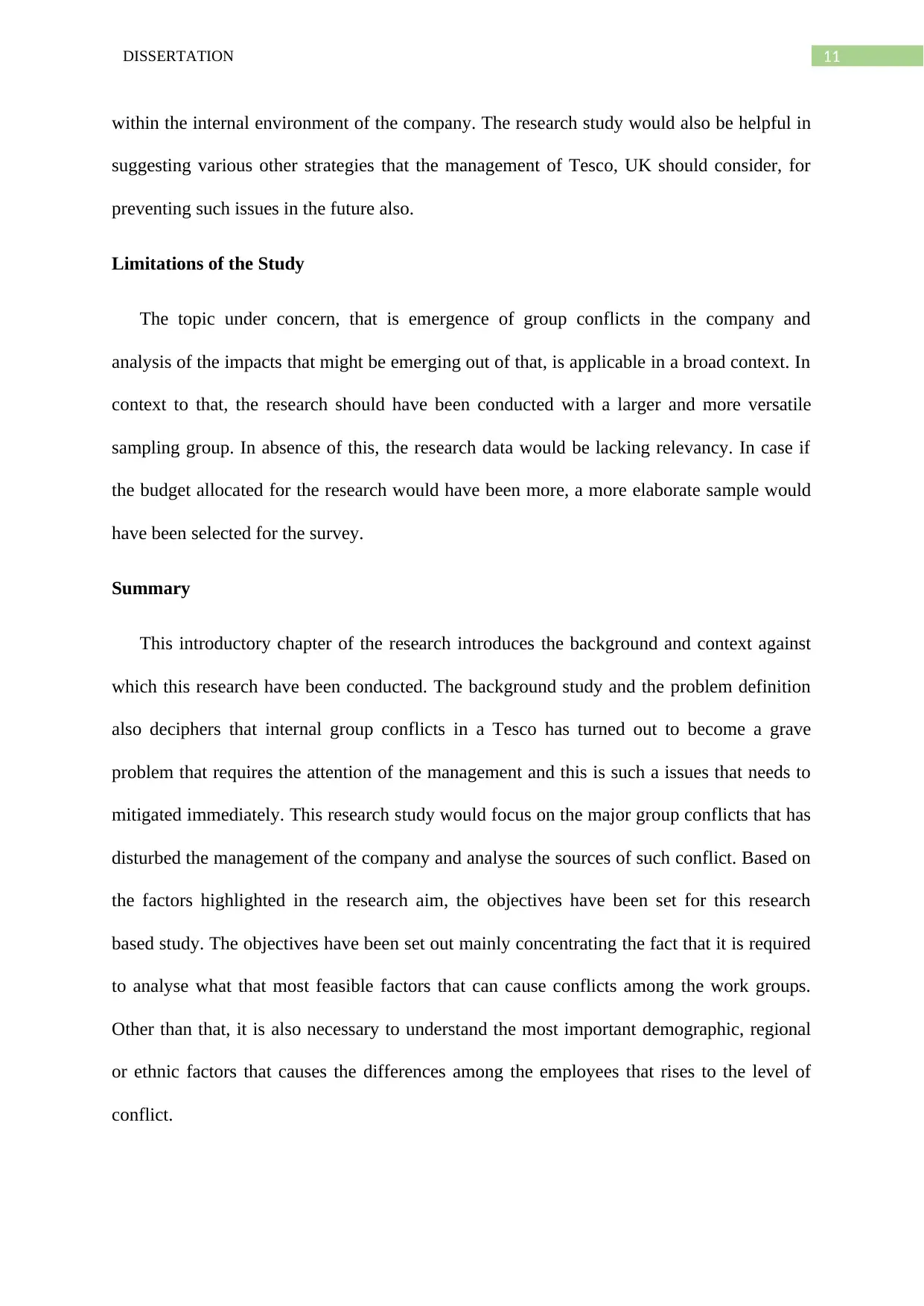
11DISSERTATION
within the internal environment of the company. The research study would also be helpful in
suggesting various other strategies that the management of Tesco, UK should consider, for
preventing such issues in the future also.
Limitations of the Study
The topic under concern, that is emergence of group conflicts in the company and
analysis of the impacts that might be emerging out of that, is applicable in a broad context. In
context to that, the research should have been conducted with a larger and more versatile
sampling group. In absence of this, the research data would be lacking relevancy. In case if
the budget allocated for the research would have been more, a more elaborate sample would
have been selected for the survey.
Summary
This introductory chapter of the research introduces the background and context against
which this research have been conducted. The background study and the problem definition
also deciphers that internal group conflicts in a Tesco has turned out to become a grave
problem that requires the attention of the management and this is such a issues that needs to
mitigated immediately. This research study would focus on the major group conflicts that has
disturbed the management of the company and analyse the sources of such conflict. Based on
the factors highlighted in the research aim, the objectives have been set for this research
based study. The objectives have been set out mainly concentrating the fact that it is required
to analyse what that most feasible factors that can cause conflicts among the work groups.
Other than that, it is also necessary to understand the most important demographic, regional
or ethnic factors that causes the differences among the employees that rises to the level of
conflict.
within the internal environment of the company. The research study would also be helpful in
suggesting various other strategies that the management of Tesco, UK should consider, for
preventing such issues in the future also.
Limitations of the Study
The topic under concern, that is emergence of group conflicts in the company and
analysis of the impacts that might be emerging out of that, is applicable in a broad context. In
context to that, the research should have been conducted with a larger and more versatile
sampling group. In absence of this, the research data would be lacking relevancy. In case if
the budget allocated for the research would have been more, a more elaborate sample would
have been selected for the survey.
Summary
This introductory chapter of the research introduces the background and context against
which this research have been conducted. The background study and the problem definition
also deciphers that internal group conflicts in a Tesco has turned out to become a grave
problem that requires the attention of the management and this is such a issues that needs to
mitigated immediately. This research study would focus on the major group conflicts that has
disturbed the management of the company and analyse the sources of such conflict. Based on
the factors highlighted in the research aim, the objectives have been set for this research
based study. The objectives have been set out mainly concentrating the fact that it is required
to analyse what that most feasible factors that can cause conflicts among the work groups.
Other than that, it is also necessary to understand the most important demographic, regional
or ethnic factors that causes the differences among the employees that rises to the level of
conflict.
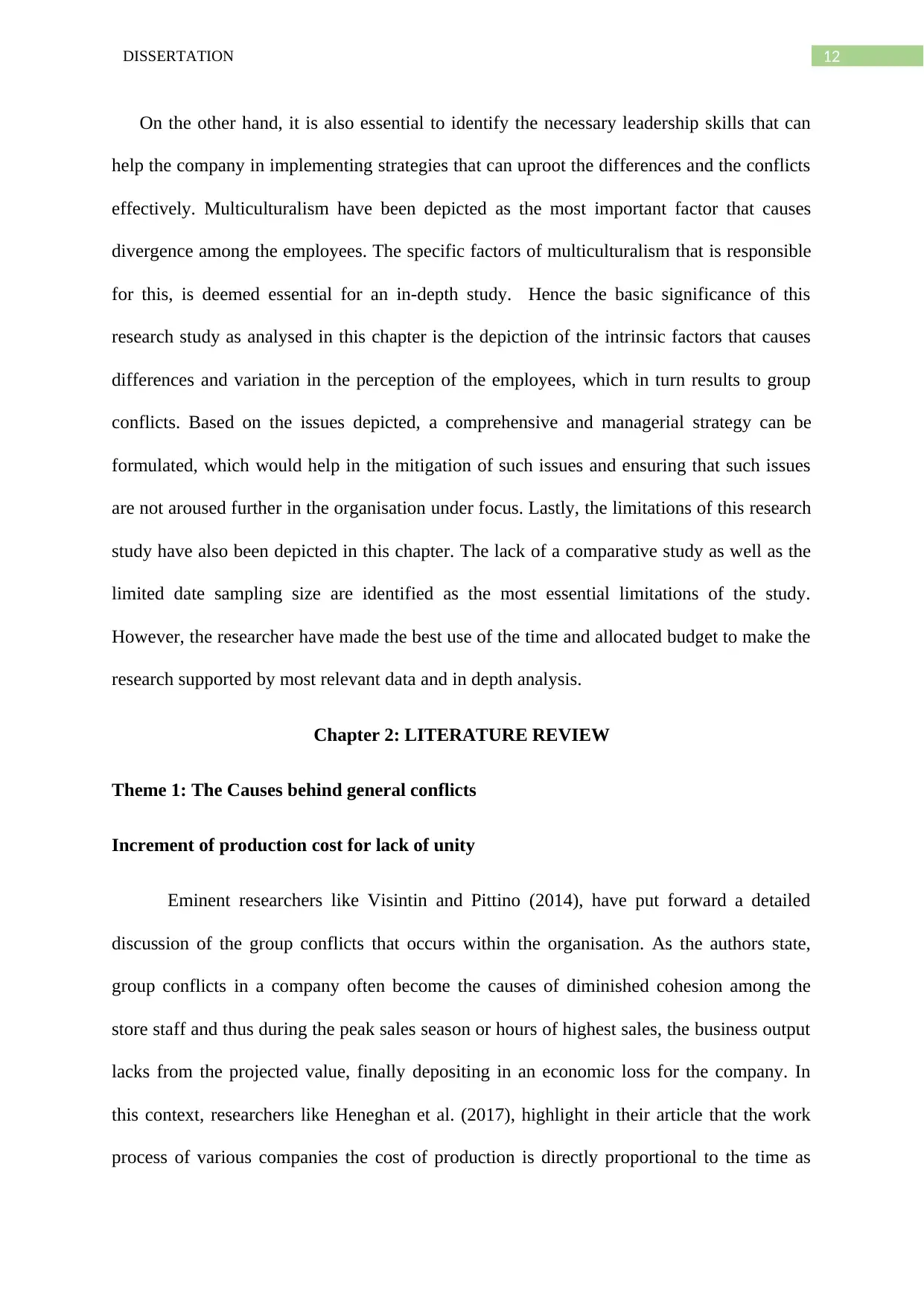
12DISSERTATION
On the other hand, it is also essential to identify the necessary leadership skills that can
help the company in implementing strategies that can uproot the differences and the conflicts
effectively. Multiculturalism have been depicted as the most important factor that causes
divergence among the employees. The specific factors of multiculturalism that is responsible
for this, is deemed essential for an in-depth study. Hence the basic significance of this
research study as analysed in this chapter is the depiction of the intrinsic factors that causes
differences and variation in the perception of the employees, which in turn results to group
conflicts. Based on the issues depicted, a comprehensive and managerial strategy can be
formulated, which would help in the mitigation of such issues and ensuring that such issues
are not aroused further in the organisation under focus. Lastly, the limitations of this research
study have also been depicted in this chapter. The lack of a comparative study as well as the
limited date sampling size are identified as the most essential limitations of the study.
However, the researcher have made the best use of the time and allocated budget to make the
research supported by most relevant data and in depth analysis.
Chapter 2: LITERATURE REVIEW
Theme 1: The Causes behind general conflicts
Increment of production cost for lack of unity
Eminent researchers like Visintin and Pittino (2014), have put forward a detailed
discussion of the group conflicts that occurs within the organisation. As the authors state,
group conflicts in a company often become the causes of diminished cohesion among the
store staff and thus during the peak sales season or hours of highest sales, the business output
lacks from the projected value, finally depositing in an economic loss for the company. In
this context, researchers like Heneghan et al. (2017), highlight in their article that the work
process of various companies the cost of production is directly proportional to the time as
On the other hand, it is also essential to identify the necessary leadership skills that can
help the company in implementing strategies that can uproot the differences and the conflicts
effectively. Multiculturalism have been depicted as the most important factor that causes
divergence among the employees. The specific factors of multiculturalism that is responsible
for this, is deemed essential for an in-depth study. Hence the basic significance of this
research study as analysed in this chapter is the depiction of the intrinsic factors that causes
differences and variation in the perception of the employees, which in turn results to group
conflicts. Based on the issues depicted, a comprehensive and managerial strategy can be
formulated, which would help in the mitigation of such issues and ensuring that such issues
are not aroused further in the organisation under focus. Lastly, the limitations of this research
study have also been depicted in this chapter. The lack of a comparative study as well as the
limited date sampling size are identified as the most essential limitations of the study.
However, the researcher have made the best use of the time and allocated budget to make the
research supported by most relevant data and in depth analysis.
Chapter 2: LITERATURE REVIEW
Theme 1: The Causes behind general conflicts
Increment of production cost for lack of unity
Eminent researchers like Visintin and Pittino (2014), have put forward a detailed
discussion of the group conflicts that occurs within the organisation. As the authors state,
group conflicts in a company often become the causes of diminished cohesion among the
store staff and thus during the peak sales season or hours of highest sales, the business output
lacks from the projected value, finally depositing in an economic loss for the company. In
this context, researchers like Heneghan et al. (2017), highlight in their article that the work
process of various companies the cost of production is directly proportional to the time as
⊘ This is a preview!⊘
Do you want full access?
Subscribe today to unlock all pages.

Trusted by 1+ million students worldwide
1 out of 78
Related Documents
Your All-in-One AI-Powered Toolkit for Academic Success.
+13062052269
info@desklib.com
Available 24*7 on WhatsApp / Email
![[object Object]](/_next/static/media/star-bottom.7253800d.svg)
Unlock your academic potential
Copyright © 2020–2026 A2Z Services. All Rights Reserved. Developed and managed by ZUCOL.





